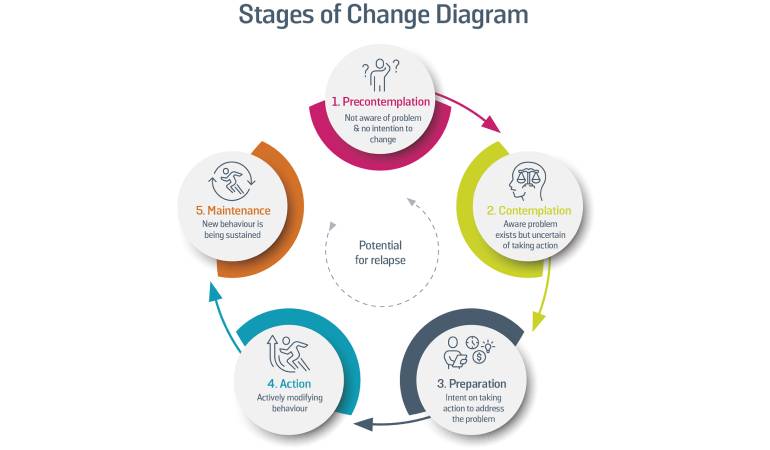
Change Happens in Stages
Let’s face it. No one is perfect. We all have quirks or flaws that need to be changed. Some changes are harder to make than others.
There are addictions such as smoking, alcohol, and drugs; and then there are what we call process or behavioral addictions. Examples of process addictions are excessive and problematic gambling, shopping, pornography use, video gaming, eating, and excessive use of a phone, as well as others.
If you’ve ever tried to stop one of these behaviors, you know just how difficult it is. Life is more of a zigzag than a straight line. It is typical to try and fail before sustaining change. It’s not personal. We all fluctuate and most of us relapse.
Let’s say that you want to lose weight, but you can’t meet your goal. Or you meet your goal but can’t sustain it. I’ve read that 45 million Americans go on a diet each year. The average adult will try 126 different diets during their life. And women give up diets after an average of five weeks, two days, and 43 minutes. That’s not promising.
But if we had a map and understood the terrain, we would have better outcomes.
In 1983, Prochaska and DiClemente developed the Stages of Change model, which describes the different stages a person goes through as they attempt to make significant changes. The model includes six well-defined stages that people move through as they work to change a target behavior.
- Precontemplation – failing to recognize the need for change.
- Contemplation – seriously considering the need for change.
- Preparation – making small changes.
- Action – fully committing to change.
- Maintenance – action lasting longer than six months.
- Termination or Relapse
Precontemplation is the entry point into the change process. The individual has not even considered the prospect of needing to address obesity. They may be content with their body, even though signs indicate they are not entirely healthy. They may say, “I don’t have a problem.”
Once the person is aware of a problem, they enter the stage called Contemplation. It is an ambivalent state where the individual considers a change of diet and fitness, but they also reject the idea. They may say, “Maybe I should lose some weight.”
In the Preparation stage, the person is ready to change. This is a window of opportunity, as they admit a need for change and gather resources. They accept the negative ramifications of their poor eating choices and inattention to health. They may say, “My weight is contributing to my poor health, and I need to do something about it.”
In the Action stage, they start to enact a plan. There are thousands of diets and multiple medications. Some are for losing weight, while others are for lowering cholesterol, living a long and healthy life, etc. There’s a saying that if you fail to plan, you plan to fail. Just pick a plan and get started.
In the Maintenance stage, the person identifies and implements strategies to maintain progress and reduce the likelihood of slips or relapses. They have sustained their diet or fitness plan for six months or more. This is what we call a “recovery” lifestyle.
Slips, lapses, and Relapses are inevitable when it comes to dieting. One can entirely avoid cigarettes, alcohol, and drugs, but we cannot live without food. We can attempt to avoid sugar and white flour, but these substances are sneaky. They are often present in our food without our knowledge.
It is important to note that the stages of change are not linear. You may find yourself moving in and out and between stages at different times. Any movement, however, is a sign of progress. There are many techniques and tools based on mental health and addiction treatments that one can use to get on track and stay on track. I created Goal Keepers: Losing Weight Is One Thing; Keeping It Off Is Another. Follow me on Goal Keepers Support on Facebook. And you can access a free download of “6 Reasons Why Maintaining Weight Loss is So Difficult” at https://www.goalkeepersupportgroup.com.
